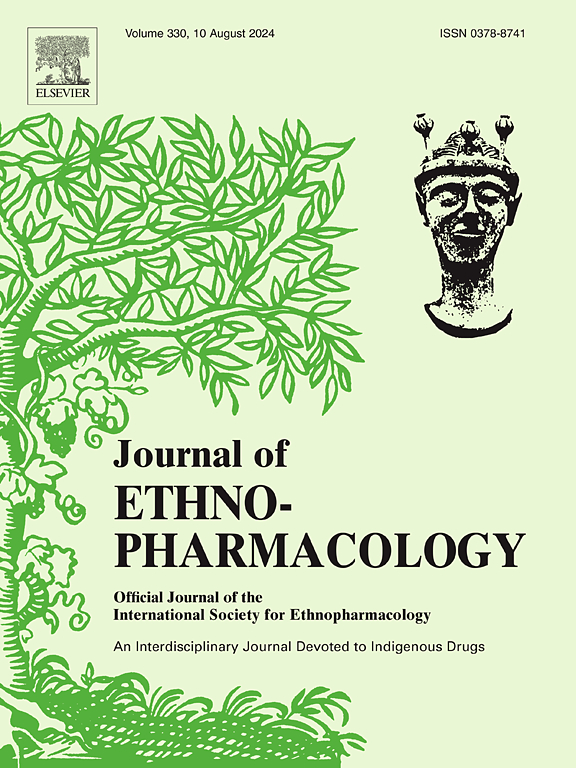Network pharmacology combines cellular experiments to investigate the anti-inflammatory phytochemicals of vine of Pueraria montana var. lobata and their mechanism
IF 4.8
2区 医学
Q1 CHEMISTRY, MEDICINAL
引用次数: 0
Abstract
Ethnopharmacological relevance
Pueraria montana var. lobata (PM) has the effects of relieving muscle stiffness and fever, generating body fluids and quenching thirst, resolving rashes, raising yang and stopping diarrhea, unblocking meridians, and detoxifying alcohol. It is commonly used for the management of conditions including stiff neck and back pain, thirst, diabetes, unresolved measles, external fever with headache, dysentery, diarrhea, dizziness and headache, stroke with hemiplegia, chest and heart pain, and alcohol poisoning. However, research on the material basis and mechanism of action of its anti-inflammatory efficacy is still quite lacking.
Aim of the study
The objective is to look into the inflammation-dampening characteristics of PM through in vitro studies and to accurately identify the phytochemicals within the therapeutic herb that correlate with its customary applications.
Materials and methods
A comprehensive phytochemical investigation was carried out using chromatographic and spectral techniques to explore the constituents of PM. Potential targets of the active chemical that might reduce inflammation were predicted using network pharmacology. The inhibition of inflammatory mediators in RAW264.7 cells stimulated by lipopolysaccharide (LPS) was used to measure the anti-inflammatory effects in vitro.
Results
The research revealed that the PM chloroform extract exhibited significant anti-inflammatory action by efficiently preventing NO release in LPS-activated RAW264.7 cells. Further phytochemical analysis led to the identification and characterization of 29 natural products, including 4 new compounds (1–4). Among these, compounds 1, 4, 7, 9–18, and 20–25 exhibited significant anti-inflammatory activity, with compound 1 showing the most potent effect. Subsequent network pharmacology, along with molecular docking and molecular dynamics simulations, suggested that 1 targets several key anti-inflammatory pathways, including HSP90AA1, MAPK, mTOR, and NF-κB. In vitro validation confirmed that the mechanism of anti-inflammation of 1 involves modulation of the HSP90AA1/MAPK/mTOR/NF-κB signaling pathways.
Conclusions
This study not only more or less supports the traditional use of PM for its anti-inflammatory properties but also introduces novel pterocarpan-type isoflavone as promising agent for inflammation management.

求助全文
约1分钟内获得全文
求助全文
来源期刊

Journal of ethnopharmacology
医学-全科医学与补充医学
CiteScore
10.30
自引率
5.60%
发文量
967
审稿时长
77 days
期刊介绍:
The Journal of Ethnopharmacology is dedicated to the exchange of information and understandings about people''s use of plants, fungi, animals, microorganisms and minerals and their biological and pharmacological effects based on the principles established through international conventions. Early people confronted with illness and disease, discovered a wealth of useful therapeutic agents in the plant and animal kingdoms. The empirical knowledge of these medicinal substances and their toxic potential was passed on by oral tradition and sometimes recorded in herbals and other texts on materia medica. Many valuable drugs of today (e.g., atropine, ephedrine, tubocurarine, digoxin, reserpine) came into use through the study of indigenous remedies. Chemists continue to use plant-derived drugs (e.g., morphine, taxol, physostigmine, quinidine, emetine) as prototypes in their attempts to develop more effective and less toxic medicinals.
 求助内容:
求助内容: 应助结果提醒方式:
应助结果提醒方式:


